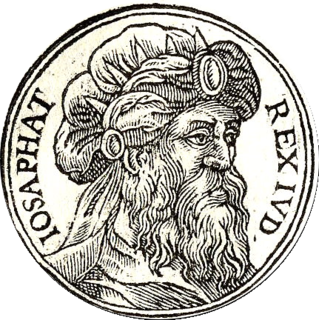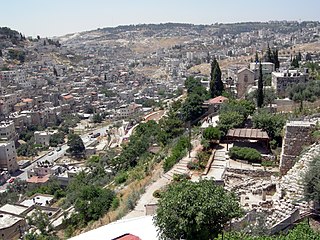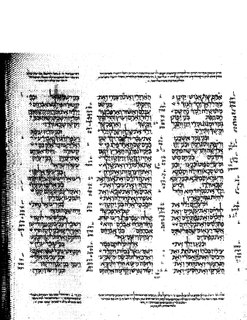Related Research Articles

The Book of Amos is the third of the Twelve Minor Prophets in the Old Testament (Tanakh) and the second in the Greek Septuagint tradition. Amos, an older contemporary of Hosea and Isaiah, was active c. 750 BC during the reign of Jeroboam II of Samaria, making Amos the first prophetic book of the Bible to be written. Amos lived in the kingdom of Judah but preached in the northern kingdom of Israel. His major themes of social justice, God's omnipotence, and divine judgment became staples of prophecy.

According to the Book of Revelation in the New Testament of the Christian Bible, Armageddon is the prophesied location of a gathering of armies for a battle during the end times, which is variously interpreted as either a literal or a symbolic location. The term is also used in a generic sense to refer to any end of the world scenario. In Islamic theology, the Armageddon is also mentioned in Hadith as the Greatest Armageddon or Al-Malhama Al-Kubra.

The Book of Judges is the seventh book of the Hebrew Bible and the Christian Old Testament. In the narrative of the Hebrew Bible, it covers the time between the conquest described in the Book of Joshua and the establishment of a kingdom in the Books of Samuel, during which biblical judges served as temporary leaders. The stories follow a consistent pattern: the people are unfaithful to Yahweh; he therefore delivers them into the hands of their enemies; the people repent and entreat Yahweh for mercy, which he sends in the form of a leader or champion ; the judge delivers the Israelites from oppression and they prosper, but soon they fall again into unfaithfulness and the cycle is repeated. Scholars consider many of the stories in Judges to be the oldest in the Deuteronomistic history, with their major redaction dated to the 8th century BCE and with materials such as the Song of Deborah dating from much earlier.

The Book of Ezekiel is the third of the Latter Prophets in the Tanakh and one of the major prophetic books in the Old Testament, following Isaiah and Jeremiah. According to the book itself, it records six visions of the prophet Ezekiel, exiled in Babylon, during the 22 years from 593 to 571 BC, although it is the product of a long and complex history and does not necessarily preserve the very words of the prophet.

The Book of Joel is collected as one of the twelve minor prophets of the Nevi'im ("Prophets") in the Hebrew Bible, and as a book in its own right in the Christian Old Testament.

Jehoshaphat, according to 1 Kings 15:24, was the son of Asa, and the fourth king of the Kingdom of Judah, in succession to his father. His children included Jehoram, who succeeded him as king. His mother was Azubah. Historically, his name has sometimes been connected with the Valley of Josaphat.

Nevi'im is the second major division of the Hebrew Bible, between the Torah (instruction) and Ketuvim (writings). The Nevi'im are divided into two groups. The Former Prophets consists of the narrative books of Joshua, Judges, Samuel and Kings; while the Latter Prophets include the books of Isaiah, Jeremiah, Ezekiel, and the Twelve Minor Prophets.
The Olivet Discourse or Olivet prophecy is a biblical passage found in the Synoptic Gospels in Matthew 24 and 25, Mark 13, and Luke 21. It is also known as the Little Apocalypse because it includes the use of apocalyptic language, and it includes Jesus' warning to his followers that they will suffer tribulation and persecution before the ultimate triumph of the Kingdom of God. The Olivet discourse is the last of the Five Discourses of Matthew and occurs just before the narrative of Jesus' passion beginning with the anointing of Jesus.

The Last Judgment, Final Judgment, Day of Reckoning, Day of Judgment, Judgment Day, Doomsday or The Day of the Lord is part of the Abrahamic religions and in the Frashokereti of Zoroastrianism.
Josaphat can refer to:

"The Day of the Lord" is a biblical term and theme used in both the Hebrew Bible and the New Testament, as in "The sun shall be turned into darkness, and the moon into blood, before the great and the terrible day of the LORD come".

The Kidron Valley is the valley originating slightly northeast of the Old City of Jerusalem, which then separates the Temple Mount from the Mount of Olives. It continues in a general south-easterly direction through the Judean desert in the West Bank, reaching the Dead Sea near the settlement of Ovnat, and descending 4,000 feet (1,200 m) along its 20-mile (32 km) course. The ancient Mar Saba monastery is located in the lower part of the valley. Other names include Arabic: وادي الجوز, Wadi el-Joz, 'Valley of the Walnut', for the upper segment near the Temple Mount; and Wadi en-Nar, 'Fire Valley', for the rest of it – with at least the segment at Mar Saba monastery also known in the 19th century as Wadi er-Rahib, 'Monk's Valley'.

The Valley of Josaphat is a Biblical place mentioned by name in the Book of Joel : "I will gather together all nations, and will bring them down into the valley of Josaphat: "Then I will enter into judgment with them there", on behalf of my people and for My inheritance Israel, whom they have scattered among the nations and they have divided up My land."; "Let the nations be roused; Let the nations be aroused And come up to the Valley of Jehoshaphat, for there I will sit to judge all the nations on every side". This location is also referred to as the Valley of Decision.
Jehoshaphat, son of Asa, was the fourth king of Judah according to 1 Kings 15:24 in the Hebrew Bible.
Biblical numerology is the use of numbers in the Bible to convey a meaning outside of the numerical value of the actual number being used. Numerological values in the Bible often relate to a wider usage in the Ancient Near East.

Zechariah 14 is the fourteenth chapter in the Book of Zechariah in the Hebrew Bible and the Old Testament of the Christian Bible. This book contains the prophecies attributed to the prophet Zechariah, and is a part of the Book of the Twelve Minor Prophets. This chapter is a part of a section consisting of Zechariah 9–14. It continues the theme of chapters 12–13 about the 'war preceding peace for Jerusalem in the eschatological future.' It is written almost entirely in third-person prophetic discourse, with seven times references to the phrase 'that day'.

2 Kings 1 is the first chapter of the second part of the Books of Kings in the Hebrew Bible or the Second Book of Kings in the Old Testament of the Christian Bible. The book is a compilation of various annals recording the acts of the kings of Israel and Judah by a Deuteronomic compiler in the seventh century BCE, with a supplement added in the sixth century BCE. This chapter focuses on the Israel king Ahaziah, the son of Ahab, and the acts of Elijah the prophet who rebuked the king and prophesied the king's death.

1 Kings 22 is the 22nd chapter of the First Book of Kings in the Old Testament of the Christian Bible or the first part of Books of Kings in the Hebrew Bible. The book is a compilation of various annals recording the acts of the kings of Israel and Judah by a Deuteronomic compiler in the seventh century BCE, with a supplement added in the sixth century BCE. This chapter belongs to the section comprising 1 Kings 16:15 to 2 Kings 8:29 which documents the period of Omri's dynasty. The focus of this chapter is the reign of king Ahab and Ahaziah in the northern kingdom, as well as of king Jehoshaphat in the southern kingdom.

2 Chronicles 19 is the nineteenth chapter of the Second Book of Chronicles the Old Testament in the Christian Bible or of the second part of the Books of Chronicles in the Hebrew Bible. The book is compiled from older sources by an unknown person or group, designated by modern scholars as "the Chronicler", and had the final shape established in late fifth or fourth century BCE. This chapter belongs to the section focusing on the kingdom of Judah until its destruction by the Babylonians under Nebuchadnezzar and the beginning of restoration under Cyrus the Great of Persia. The focus of this chapter is the reign of Jehoshaphat, king of Judah.

2 Chronicles 20 is the twentieth chapter of the Second Book of Chronicles the Old Testament in the Christian Bible or of the second part of the Books of Chronicles in the Hebrew Bible. The book is compiled from older sources by an unknown person or group, designated by modern scholars as "the Chronicler", and had the final shape established in late fifth or fourth century BCE. This chapter belongs to the section focusing on the kingdom of Judah until its destruction by the Babylonians under Nebuchadnezzar and the beginning of restoration under Cyrus the Great of Persia. The focus of this chapter is the reign of Jehoshaphat, king of Judah.
References
- ↑ Joel 3:14
- ↑ Thieme, R. B., Lesson Summaries: Year 1967: Series: Joel, accessed 20 October 2018
- ↑ Hitchcock, Mark (1999). The Complete Book of Bible Prophecy. Tyndale House Publishers, Inc. p. 113. ISBN 0-8423-1831-3.